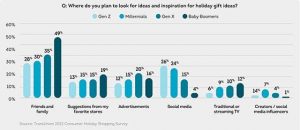With B2B’s increasing reliance on intent data, now is a good time to assess its current state and prepare for what’s ahead.
In B2B sales and marketing, intent has become an essential ingredient as salt and pepper are in cooking. You wholeheartedly believe it is required in every recipe, but you’re not always sure of the right amount or when to apply it.
With our increasing reliance on intent data and its broadening definition, now is a good time to assess the state of intent and plan on what might be ahead.
I tapped into a group of trusted B2B marketers to gain perspective on all things intent. In this article, we will:
- Sprinkle in knowledge gained from a recent roundtable with B2B marketing leaders on the data, tools and processes used in sales and marketing account-based go-to-market (GTM) motions.
- Get a broad view from three savvy data and intent executives who have seen a few things in building Michelin-rated worthy GTM strategies.
Together, we can capture a snapshot of intent’s current state, understand the challenges and opportunities and preview what should be on the menu going forward.
What is the number one value proposition of intent in today’s GTM efforts?
Marketing is playing a larger, more proactive role in the buying-selling process. With B2B buyers and buying teams spending more time doing their research online and through peer networks, sales has less access to buyers.
This big shift has thrust intent into the spotlight to identify and prioritize the right accounts to reach out to based on account and buyer behavior and, in turn, catapulting outbound sales and outreach as today’s number one intent use case.
Mike Burton, co-founder and head of commercial sales at intent industry pioneer Bombora, puts it this way:
“Because sales sit so close to revenue, intent data can galvanize action and increase sales productivity. This sales use case has a compound effect making other GTM functions more impactful including demand gen, SDRs and field marketers.”
Orchestrated timing between sales and marketing still remains a significant challenge, largely because of the data, tech and process silos that exist across departments.
Intent data is being relied on to integrate GTM motions and define roles across functions helping sales and marketing stay in sync and to identify the best opportunity accounts at the right time.
Kerry Cunningham, director of research at revenue technology leader 6Sense, shares:
“Most buyers are researching your solution and don’t know your company or solution exists. Here’s the reality — you lose 100% of the deals you don’t compete for. The goal is to never miss an opportunity when your solution can solve a customer problem or fill a need.
Intent plays an essential role in exposing account timing and need to prioritize account and buyer engagement.”
What can GTM leaders do now to get more value from intent signals?
Sales and marketing teams are not leveraging intent to its full value or potential yet.
Beyond account identification and prioritization (timing), more GTM teams are starting to apply intent to identify and align buyer and account needs with contextual content and messaging.
David Crane, VP of portfolio marketing and marketing chief of staff at intent aggregator Intentsify, says:
“If we boil down all the use cases across all the GTM functions that leverage intent data, the common denominator is efficiency.
“Rather than marketers, BDRs, sales pros and customer success reps having to spend valuable time and effort to understand buyers’ specific needs and pains, they can gain insights directly from intent signals.
“Done right, GTM teams can quickly supply buyers with the information they want (e.g., content, creative assets, talk tracks) when they need it.”
As more GTM teams adopt account-based tools and more effectively use their websites to implement and manage ABM programs, intent’s value is increasing.
More than a quarter of an ABM platform’s value is the intent data it generates to use in sales and marketing activities, according to Gartner.
When intent powers ABM tools and an organization’s webpages and these components are used together, marketers highlight the increased intelligence they can put to work resulting in higher conversions to sales opportunity and revenue.
Cunningham emphatically states:
“The most valuable signals we don’t pay attention to are on your website. Only 3% of visitors fill out forms, so relying on this tactic is futile. Rather, deanonymizing traffic and using intent is the key to unlocking immediate opportunity. GTM teams need to harvest this info otherwise, you will waste all that marketing and sales time and effort.”
Where can intent play the biggest role in the immediate future?
With the changing B2B buying-selling landscape, experts highlight that to get more value out of intent data investment, we must:
- Focus on where and how to apply intent during the GTM process.
- Collapse data and functional silos that leave big gaps.
Bombora’s Burton cites two areas in his work across more than 650 customers:
“The first is using intent for strategic planning. This means understanding what is happening across different cohorts of your total available market (TAM) and where your target accounts are in their buying stages.
The second is augmentation of first-party anonymous data, especially as third-party data becomes scarcer. We see leading organizations creating a first-party data mart and augmenting it with intent data. Having this info appended allows for precision targeting at scale.”
Crane weighs in on what he is seeing across a rapidly growing Intentsify customer base:
“First, GTM teams and the data science and ops teams that support them, need to get better about baking intent data into their GTM strategies from the start. Today, intent data is treated more like an after-market component that individual roles use but don’t always share across functions.
Secondly, GTM teams need to improve how they convert intent signals into actionable insights as well as their processes for quickly acting on those insights while the data is still relevant. These challenges are likely a consequence of difficulty in effectively leveraging multiple intent data sources, which we see more and more B2B teams focused on solving.”
Intent as marketing’s essential ingredient in GTM strategy
Intent data is seeing an unprecedented rate of adoption as B2B GTM teams focus on:
- Efficiency and productivity internally.
- Customer experience and engagement with buyers and accounts externally.
While outbound sales are the top use case today for intent as noted by our experts, we’re seeing marketing teams be the driver of activation. As Cunningham succinctly summarizes:
“Marketing’s job is to ensure organizations never miss out on an opportunity to compete for a deal; this is how marketing becomes indispensable!”
The post The state of intent data in 2023 and beyond appeared first on MarTech.
MarTech(44)
Report Post



